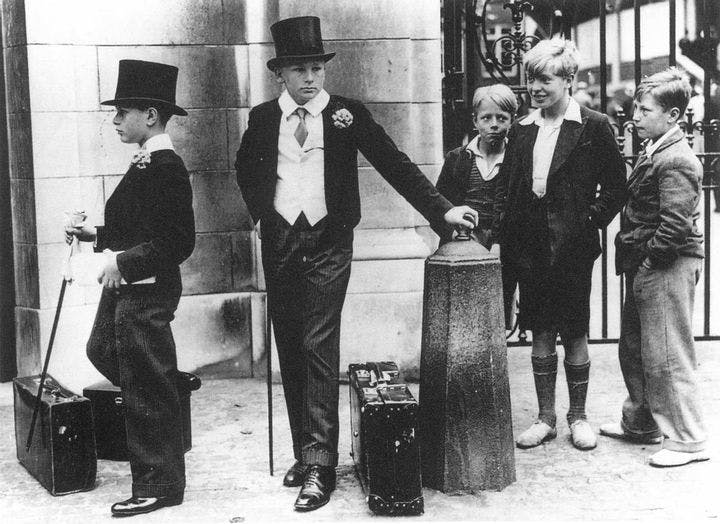Fall 2010
Triumph of the Toughs
– The Wilson Quarterly
In the decades since, the picture has illustrated countless articles about rich and poor.
On July 10, 1937, the British daily newspaper the News Chronicle published a photograph of five boys, two of them dressed in the English gentleman’s uniform of top hat, tail coat, and silk waistcoat, and carrying canes. The three other boys stand to the side, smirking at the dandies, wearing oversized jackets, perhaps bought to last longer as the boys grew. Above the photo, taken by Jimmy Sime, the headline read, “Every Picture Tells a Story,” and below it was a no-nonsense caption: “Outside Lord’s, where the Eton-Harrow match opened yesterday.” There was no accompanying article. The message of Britain’s sharp class division was self-evident.
In the decades since, the picture has illustrated countless articles about rich and poor, and even graced the covers of two books. The photo speaks for itself; nothing more need be said. But Guardian columnist and former Granta editor Ian Jack tracked down each of the boys, and the story is quite different from what the picture so plainly suggests.
The photo’s two “toffs,” as later iterations of its captioning labeled them, were Peter Wagner and Thomas Dyson, both Harrow students. In the picture, Wagner stares down the street, awaiting his parents’ arrival to take him and his friend Dyson home for the weekend. The Wagners were quite wealthy. They had arrived in England from Germany via South Africa in the late 19th century. Peter’s father, Richard Harry Wagner, went to Harrow on a scholarship and made out quite well. He and his wife may have arrived in the family’s Rolls-Royce just minutes after the picture was snapped. But a rough road lay ahead for young Peter: After attending the University of Cambridge, marrying, and starting a family, he began to be haunted by mental illness. He died in a locked ward of a mental asylum at age 60.
Peter’s friend Thomas Dyson fared worse. His English father and Australian mother were stationed in India with the Royal Field Artillery. (It’s ironic that a boy of German heritage and another who was half-Australian came to symbolize the upper echelons of English society.) Just a year after the photo was taken, he sailed to Bombay and boarded a train to visit his parents. During the journey he fell ill with diphtheria, and died on August 26, 1938, at age 16.
By contrast, the picture’s three “toughs” did quite well. Not toughs at all, but from the “typically straitened circumstances of the old London working class,” George Young, George Salmon, and Jack Catlin all lived well into old age, enjoying successful careers and good health. Young ran a window-cleaning business, and his four sons joined the trade. Salmon worked as a foreman for Imperial Metal Industries and helped the company expand across Europe. Catlin joined the civil service and rose to a senior position in the Department of Health and Social Security. “We’ve always been jolly happy,” Young once told a reporter, “just as we were when I was a kid. You don’t need to be rich. We’ve had a very rich life.”
Today, Jack observes, class trappings aren’t visible in the same way—a photographer looking for such a shot might find five boys dressed all quite alike, in jeans and T-shirts. “Giving a superficial impression of equality,” Jack writes, “the picture would be even more of a lie than before.”
THE SOURCE: “Five Boys: The Story of a Picture” by Ian Jack, in Intelligent Life, Spring 2010.
Cover photo courtesy of Wikimedia Commons
